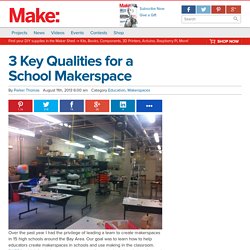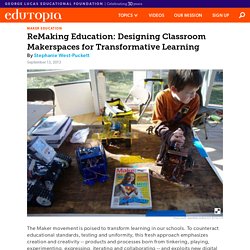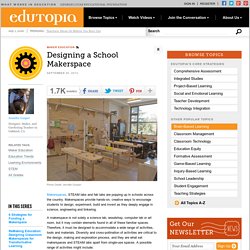

3 Key Qualities for a School Makerspace. Over the past year I had the privilege of leading a team to create makerspaces in 15 high schools around the Bay Area.

Our goal was to learn how to help educators create makerspaces in schools and use making in the classroom. DARPA, which funded our program, eventually wanted to take what we learned and create makerspaces in 1,000 schools. While our DARPA funding ended in December, we believed so strongly in the benefits of these spaces that we continued to support our pilot schools until the end of the year. This was particularly rewarding work. Most of us have enjoyed watching someone’s eyes light up at Maker Faire, but listening to a high schooler describe his or her first open-ended project was very powerful. Every space in our program was different.
Process Making requires two sets of skills and the confidence to try something new. The second set of skills can be thought of as diagnostic and problem-solving skills. The first is what we call a level I project or a skill builder. What’s in a MakerSpace? By Sylvia Libow Martinez and Gary S.

Stager A well-equipped modern MakerSpace features flexible, computer-controlled manufacturing equipment for creating, cutting, and forming plastics, metal, plaster, and other common materials, including: 3D printers that are capable of producing three-dimensional objects. Cutting machines that cut a variety of materials with precision. The cutting element can be a laser, water jet, knife, or other material.
Deciding what to focus on first may seem like a daunting task. There is no absolute shopping list of must haves. Get started, do something, and refine as you see what works in your classroom. Kurti-article.pdf. ReMaking Education: Designing Classroom Makerspaces for Transformative Learning. The Maker movement is poised to transform learning in our schools.

To counteract educational standards, testing and uniformity, this fresh approach emphasizes creation and creativity -- products and processes born from tinkering, playing, experimenting, expressing, iterating and collaborating -- and exploits new digital tools to make, share and learn across space and time, do-it-yourself (DIY) style. Museums, libraries, community centers and after-school programs have designed physical and virtual "makerspaces" to host communities of supportive peers and mentors invested in creating everything from nail polish design and webpages to jewelry and robots . . . and now, even school curriculum. Inventing Production-Centered Schools Makers, using grounded research on how students learn outside of class, are rethinking schools. Rethinking Your Classroom Like you, students need to find nurturing places in real life and on the web to geek out with others who share their passion.
Maker Resources. Designing a School Makerspace. Makerspaces, STEAM labs and fab labs are popping up in schools across the country.

Makerspaces provide hands-on, creative ways to encourage students to design, experiment, build and invent as they deeply engage in science, engineering and tinkering. A makerspace is not solely a science lab, woodshop, computer lab or art room, but it may contain elements found in all of these familiar spaces. Therefore, it must be designed to accommodate a wide range of activities, tools and materials. Diversity and cross-pollination of activities are critical to the design, making and exploration process, and they are what set makerspaces and STEAM labs apart from single-use spaces.
A possible range of activities might include: Cardboard construction Prototyping Woodworking Electronics Robotics Digital fabrication Building bicycles and kinetic machines Textiles and sewing Designing a space to accommodate such a wide range of activities is a challenging process. Ask the Right Questions Going Forward. Makerspace-Playbook-Feb-2013.pdf. Eli7095.pdf. How to Make a Makerspace. To make it easier, Artisan’s Asylum and Maker Media have teamed up with a large group of founders, technical specialists, and makerspace community members to offer you a body of written materials designed to boil down a lot of our lessons learned and help you through the challenges ahead!

Start with these short pieces, written for the MAKE Blog: As you start putting together your business model, check out the financial projections worksheet we use in our one-day Maker Con workshop (offered before the New York and San Mateo Maker Faires in 2013 and 2014). Presentations and handouts from our 2-day inaugural February 2013 conference are available and for download through dropbox here. Notes and video from some of the presentations are available at The following information was part of the original call for attendees for that event: What’s a makerspace? To describe them simply, makerspaces are community centers with tools. What’s this event? Who’s this for? What’s the program?